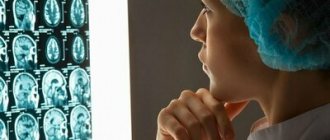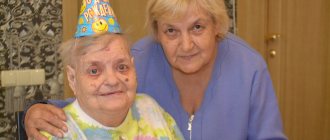Parkinsonism or Parkinson's syndrome is a pathological condition that is manifested by stiffness in movements, involuntary trembling of the limbs and head, and constant muscle hypertonicity. As a rule, parkinsonism is associated with various organic pathologies of the brain.
Parkinson's syndrome should not be confused with Parkinson's disease - the disease is considered an independent disease with similar symptoms. And parkinsonism is a syndrome that can develop secondary (for example, after exposure to toxins, traumatic brain injuries).
Symptoms of Parkinsonism
Parkinsonism has a number of characteristic symptoms that make it possible to clearly differentiate this disease:
- Trembling of the limbs and head. The peculiarity is that the tremor occurs at rest and subsides when attempting to move.
- Muscle stiffness, tension, hypertonicity. It intensifies with repeated monotonous movements; it is difficult for the patient to perform them for a long time.
- A characteristic posture for parkinsonism: the back is hunched, the limbs are tucked towards the body, the head is always tilted forward.
- Unsteady, shuffling gait – the patient moves in small steps and does not lift the foot off the floor well.
- With Parkinsonism, patients often fall and lose their balance.
- Motor poverty - it is difficult to start moving, they are slow.
- Facial activity decreases.
- Speech becomes quiet and monotonous.
- The patient's memory is noticeably poorer and there are disturbances in thinking.
- Psychological disorders – low mood, tendency to criticize.
- The skin becomes greasy.
- Salivation increases, and in some patients severe drooling may be observed.
- There is another characteristic feature - a tendency to constipation, rare stools, and impaired peristalsis.
Even characteristic symptoms do not guarantee a reliable diagnosis. Therefore, it is necessary to undergo a full examination.
At CELT you can get advice from a neurologist.
- Initial consultation – 4,000
- Repeated consultation – 2,500
Make an appointment
Diagnosis and treatment of parkinsonism at the Yusupov Hospital
Only after finding out the nature of the disease, neurologists at the Yusupov Hospital prescribe treatment to patients depending on its cause and severity of symptoms. Is there a cure for Parkinson's syndrome? Some types of secondary parkinsonism are potentially reversible: neuroleptic parkinsonism (treated with medication), parkinsonism with hydrocephalus, or a space-occupying lesion is treated surgically, parkinsonism due to Wilson's disease with the modern administration of drugs that promote the formation of chelating complexes. Difficult to control parkinsonism are diseases of the parkinsonism+ group, in which, along with a lack of synthesis and transport of dopamine, postsynaptic structures carrying dopamine receptors often suffer.
After therapy, patients’ quality of life improves, the severity of symptoms decreases, and their ability to work is partially restored. You can get a consultation with a neurologist by making an appointment in advance by calling the Yusupov Hospital.
Forms
There are two main types of parkinsonism:
- Primary
. This is Parkinson's disease, an independent disease. May be associated with other diseases, but not caused by them. - Secondary
. Occurs against the background of injury, poisoning, or other disease. It is a consequence, not a cause. Accordingly, treatment requires a different approach.
There are several forms of secondary disease, which are classified based on the preconditions of the disease.
- Infectious parkinsonism - develops after an infection. Most often, encephalitis, influenza, and syphilis act as provoking diseases.
- Vascular - develops in the post-stroke period. May be caused by chronic cerebrovascular accident.
- Toxic – a consequence of ingestion or exposure to various toxins. One of the forms - medicinal - develops against the background of taking pharmaceutical drugs.
- Traumatic – consequences of a head injury. It can occur with regular head injuries, for example, in athletes - wrestlers, boxers.
- Tumor - caused by brain tumors.
- Idiopathic is the name given to diseases whose cause has not been reliably determined. If there is a complete symptom complex of Parkinson's syndrome, then this diagnosis is made, despite the absence of an obvious cause.
Types of secondary, symptomatic parkinsonism
The following types of secondary, symptomatic parkinsonism are distinguished:
- drug. It can be provoked by neuroleptics, lithium preparations, rauwolfia preparations, serotonin reuptake inhibitors, α-methyldopa, calcium antagonists;
- toxic. Develops as a result of the toxic effect of the organic compound MPTP, manganese, carbon monoxide, carbon disulfide, cyanide, methanol, organophosphorus compounds, and petroleum products;
- with volumetric processes of the brain (malignant and benign tumor, syphilitic gumma, tuberculoma in the area of the basal ganglia or substantia nigra);
- vascular. Develops with infarctions in the basal ganglia, thalamus, frontal lobes or midbrain, as well as diffuse ischemic lesions of the white matter (Binswanger's disease);
- posthypoxic, caused by bilateral necrosis of the basal ganglia, which are very sensitive to ischemia and hypoxia due to the lack of collateral blood flow;
- encephalitic (with neuroborreliosis, AIDS, progressive consequences of Economo's encephalitis lethargica);
- traumatic (boxer encephalopathy, consequences of severe traumatic brain injuries);
- for hydrocephalus (for obstructive or normotensive internal or mixed hydrocephalus).
Parkinsonism occurs in the following degenerative diseases with damage to the extrapyramidal system (atypical parkinsonism, “parkinsonism-plus”), this is the most severe group of diseases, more malignant than Parkinson’s disease:
- multisystem atrophy, which includes three types: striatonigral degeneration, olivopontocerebellar degeneration, Schry-Diger syndrome;
- multiple system atrophies;
- progressive supranuclear palsy (Steele-Richardson-Olszewski disease);
- corticobasal degeneration;
- diffuse Lewy body disease;
- Alzheimer's disease;
- parkinsonism-ALS-dementia;
- Creutzfeldt-Jakob disease, etc.;
Parkinsonism can be classified as a separate group in storage diseases due to genetically determined dysmetabolic disorders:
- Fahr's disease (calcium builds up in the brain);
- Wilson's disease (copper accumulation).
Causes
The main cause of the disease is the death of neurons in the area of the brain that is responsible for the coordinated action of muscles and muscle tone. Neurologists have also noted a lack of dopamine in this area of the brain, which causes symptoms such as tremors and muscle stiffness. But there are quite a lot of risk factors or prerequisites. They do not necessarily directly lead to the development of the disease, but they significantly increase its likelihood.
Only a neurologist can identify the exact cause after a full examination.
Parkinson's disease - what is it?
When the substantia nigra of the brain is damaged and signal conduction is disrupted, degenerative disorders begin to occur in the central nervous system. The progression of the disease is very slow. Often, only a highly qualified neurologist can diagnose the initial stage for decades. The symptoms of the disease were first described in 1877 by the doctor D. Parkinson, who called the disease “continuous paralysis.” This name is associated with the main manifestation options:
- trembling of the limbs starting from the fingertips;
- slowness of movements;
- muscle rigidity.
The manifestation is associated with the onset of disturbances in the production of dopamine. Deprived of this chemical, areas of the brain gradually begin to die. The ability to conduct nerve impulses is impaired. This provokes the appearance of tremor in the early stages. Over the years, rigidity develops, leading to impaired ability to move independently.
Our doctors
Pankov Alexander Rostislavovich
Neurologist
40 years of experience
Make an appointment
Novikova Larisa Vaganovna
Neuropathologist, Candidate of Medical Sciences, doctor of the highest category
Experience 39 years
Make an appointment
Belikov Alexander Valerievich
Neurologist, Candidate of Medical Sciences
21 years of experience
Make an appointment
Stages of development of Parkinson's disease
Insomnia, unreasonable fatigue, constipation, and impaired sense of smell may be suspected signs of the potential development of Parkinson's disease. But experts diagnose the onset of pathology only if precise signs are present. The disease then goes through the following stages:
- Unilateral onset of motor symptoms, neck rigidity is evident, and tremor is observed only on one side. The duration of the first stage ranges from 6 months to three years.
- At the second stage, bilateral but asymmetrical manifestations are observed. Duration for mature patients is up to three years, for young patients up to 10 years.
- The third stage is characterized by the addition of instability to bilateral movement disorders. With properly selected therapy, the duration can be “stretched” to 15 years or more.
- At the fourth stage, it becomes difficult for the patient to turn in bed, noticeable axial apraxia develops when standing, the patient loses balance, problems arise when moving from a sitting position to a standing position, or getting out of bed after a lying position. The patient begins to need constant outside help. He is no longer able to take walks on his own and often even just walk on his own. Maximum duration 5 years.
- At the fifth stage, the patient is completely confined to a bed or wheelchair. He practically loses the ability to move and cannot swallow. The disease enters the thermal stage. One of the common causes of death is congestive or aspiration pneumonia.
The use of modern drugs makes it possible to maximize the duration of each stage, extending the thermal period as far as possible.
Diagnostics
MRI of the brain
- Cost: 14,000 rub.
More details
First, the doctor collects anamnesis. The patient is asked the following questions:
- How long ago did the symptoms first appear and how quickly did they progress?
- Does the tremor get worse at rest?
- Are there hereditary prerequisites for the development of the disease?
- Does the patient work in industries with increased toxic hazards?
- Is the patient taking medications that increase the risk of developing parkinsonism?
- Have there been severe episodes of infectious disease in the recent past?
- Were there any head injuries?
Then the doctor conducts a standard neurological examination for such complaints: assesses gait, muscle tone, tremor pattern, etc.
The next stage is a pharmacological test. It consists of prescribing a drug based on dopamine or similar substances to the patient. If you have parkinsonism, this helps reduce symptoms.
Often a consultation with a psychologist is required to assess the cognitive and emotional sphere. Typically, standard tests and questionnaires are used for this.
The diagnosis can be confirmed with an MRI - the examination will show pathological areas in the area responsible for muscle tone and coordination. These highlighted areas show dead neurons. MRI can also confirm or exclude a tumor.
Diagnostics ends with a diagnosis, according to which treatment is prescribed.
Symptoms of Parkinsonism are disorders of movement and muscle tone and their combinations. Stiffness of movements, increased tone, tremors of the hands and head, chewing-type movements of the lower jaw, disturbances in handwriting and precision of movements, gait “bent over”, small steps, “shuffling”, poverty of facial movements - “frozen face”, decreased emotionality of behavior , depression. Symptoms of the disease, initially one-sided, further progress, in severe cases leading to disability, immobility, and cognitive impairment.
The main clinical syndrome in Parkinson's disease and parkinsonism is akinetic-rigid or hypertensive-hypokinetic. Shaking paralysis and parkinsonism are characterized by hypo- and akinesia. A peculiar flexion posture appears: the head and torso are tilted forward, the arms are half-bent at the elbow, wrist and phalangeal joints, often tightly brought to the lateral surfaces of the chest and torso, the legs are half-bent at the knee joints. Poor facial expressions are noted. The rate of voluntary movements gradually slows down with the development of the disease, sometimes complete immobility can occur quite early. The gait is characterized by small shuffling steps. There is often a tendency to involuntary run forward (propulsion). If you push the patient forward, he runs to avoid falling, as if “catching up with his center of gravity.” Often a push to the chest leads to running backwards (retropulsion) or to the side (lateropulsion). These movements are also observed when trying to sit down, stand up, or throw your head back. Often, with pronounced parkinsonism syndrome, the patient’s postures resemble cataleptic ones. Akinesis and plastic hypertension are especially pronounced in the muscles of the face, masticatory and occipital muscles, and muscles of the limbs. When walking, there are no friendly movements of the arms (acheirokinesis). Speech is quiet, monotonous, without modulation, with a tendency to fade at the end of the phrase.
During passive movement of the limb, a kind of muscle resistance is noted due to an increase in the tone of the antagonist muscles, the “gear wheel” phenomenon (the impression arises that the articular surface consists of the clutch of two gear wheels). An increase in the tone of antagonist muscles during passive movements can be determined by the following technique: if you raise the head of a person lying down, and then suddenly release your hand, the head will not fall on the pillow, but will fall relatively smoothly. Sometimes the head is slightly elevated when lying down - the “imaginary pillow” phenomenon.
Tremor is a characteristic, although not obligatory, symptom of parkinsonism syndrome. This is a rhythmic, regular, involuntary trembling of the limbs, facial muscles, head, lower jaw, tongue, more pronounced at rest, decreasing with active movements. Oscillation frequency is 4-8 per second. Sometimes finger movements in the form of “rolling pills” or “counting coins” are noted. The tremor intensifies with excitement and practically disappears in sleep.
Mental disorders are manifested by loss of initiative, activity, narrowing of horizons and interests, a sharp decrease in various emotional reactions and affects, as well as some superficiality and slowness of thinking (bradyphrenia). Bradypsychia is observed - difficult active switching from one thought to another, acairia - stickiness, viscosity, egocentrism. Sometimes paroxysms of mental excitement occur.
Autonomic disorders manifest themselves in the form of greasiness of the skin of the face and scalp, seborrhea, hypersalivation, hyperhidrosis, trophic disorders in the distal parts of the extremities. A violation of postural reflexes is detected. Sometimes special research methods are used to determine breathing that is irregular in frequency and depth. Tendon reflexes are usually without deviations. In atherosclerotic and postencephalitic parkinsonism, increased tendon reflexes and other signs of pyramidal insufficiency can be detected. With postencephalitic parkinsonism, so-called oculogyric crises occur - fixation of gaze upward for several minutes or hours; sometimes the head is thrown back. Crises can be combined with a violation of convergence and accommodation (progressive supranuclear palsy).
It is customary to distinguish several clinical forms of shaking palsy and parkinsonism; rigid-bradykinetic, tremulous-rigid and tremulous. The rigid-bradykinetic form is characterized by an increase in muscle tone according to the plastic type, a progressive slowdown of active movements up to immobility; muscle contractures and flexor posture of patients appear. This form of parkinsonism, the most unfavorable in its course, is more often observed in atherosclerotic and less often in postencephalitic parkinsonism. The trembling-rigid form is characterized by tremor of the extremities, mainly their distal parts, which is accompanied by stiffness of voluntary movements as the disease develops. The trembling form of parkinsonism is characterized by the presence of constant or almost constant medium- and large-amplitude tremor of the limbs, tongue, head, and lower jaw. Muscle tone is normal or slightly increased. The tempo of voluntary movements is maintained. This form is more common in postencephalitic and posttraumatic parkinsonism.
A person's movements, muscle control and balance of the body in space are impaired. This condition is formed precisely due to the destruction of the accumulation of part of the nerve cells (substantia nigra) of the brain stem. These nerve cells are connected by their fibers to both hemispheres of the brain. They produce and release special substances (neurotransmitters) that help control the movements and coordination of the body in space. Their absence leads to the appearance of such outwardly noticeable signs of parkinsonism as a decrease in the range of movements with an increase in muscle tone, trembling of the limbs, a mask-like facial expression, walking in small steps and similar symptoms.
Prognosis and prevention of Parkinson's disease
Today, this disease remains incurable. Today doctors cannot offer drugs that can restore the structure of the brain. The prognosis of development is related to the age of the patient and the presence of concomitant diagnoses.
The severity of symptoms makes it possible to reduce timely diagnosis and prescribe effective therapy. The development forecast depends on:
- age of first manifestations, the younger, the more strength the body has to resist rapid development with frequent attacks leading to the death of neurons;
- prospects for the use of modern drugs, including Levodopa. Today in the Russian Federation this drug is included in the list of medications prescribed to federal beneficiaries under SNILS;
- the possibility of using innovative surgical methods, most often offered to young and middle-aged patients who are able to withstand surgery.
Due to the lack of accurate data on the causes of the onset of Parkinson's disease, exact methods of prevention are also unknown. But to reduce risks, it is recommended to lead a healthy lifestyle and stop taking drugs and alcohol. Regular medical examinations become an important prevention option.
Etiology
The main reasons for the development of parkinsonism include:
- medications (neuroleptics, metoclopramide, prochlorperazine);
- intoxication;
- viral encephalitis;
- structural changes in the brain matter after strokes, tumors and other cerebral pathologies;
- traumatic brain injuries;
- vascular disorders;
- Wilson-Konovalov disease.
Parkinsonism can also occur against the background of other neurodegenerative diseases: Alzheimer's disease, multifocal system atrophy, dementia with Lewy bodies, etc.
Treatment of Parkinson's disease
The duration and quality of life of the patient directly depends on the chosen therapy and the timely start of taking medications. Constant monitoring of health status by the treating neurologist is required.
In the early stages, drug treatment with drugs that activate the production and synthesis of dopamine is used. Additionally, drugs are used that reduce the breakdown of this neurotransmitter. Dopamine receptor antagonists are prescribed. They will be based on pramipexole, ropinirole, rotigotine. MAO inhibitors type B, based on rezalgin, are prescribed. By the third stage, the administration of Levodopa begins. In patients over 70 years of age, the use of this drug is recommended from the moment of diagnosis. The disadvantage of Levodopa is its rapid addiction with the need for a stable increase in dosage. In the older age group, Levodopa is prescribed taking into account concomitant age-related diagnoses.
Additionally, it is recommended to take vitamins that include magnesium. Vitamins A and D. The diet includes spinach, carrots, tomatoes, green onions and other vegetables.
In the absence of contraindications, surgical intervention may be recommended:
- deep electrical stimulation of the brain;
- stereotaxy;
- the use of stem cells capable of replacing dead neurons when transplanted.
Surgery often significantly improves the patient's condition.
Parkinson's disease and life expectancy
Even a very experienced doctor cannot indicate the exact life expectancy when diagnosing the disease. In this neurophysiological disease, brain cells gradually die. What is the prognosis for the long-term development of the disease to severe stages with constant treatment and monitoring by a specialist? Many patients go through the stages of the disease over several decades.
The worst prognosis is given to elderly patients. In this case, Parkinson's disease can reach the thermal stage in just one and a half to two years. The akinetic-rheid type of the disease is also distinguished by its rapid development and progression through all stages. Many young patients, with adequate therapy, are able to live a full life and pass on to another world simply from old age for natural reasons.
The duration of the flow is influenced by many additional factors. Including constant contact with the attending physician, correlating the course of therapy. On average, the duration of development of all stages of the disease lasts 20-25 years. If the pathology begins at a young age, this period can increase to 40-50 years.
The reduction in time is associated with late diagnosis or refusal of treatment. In this option, the patient may die within 2-8 years after diagnosis.










